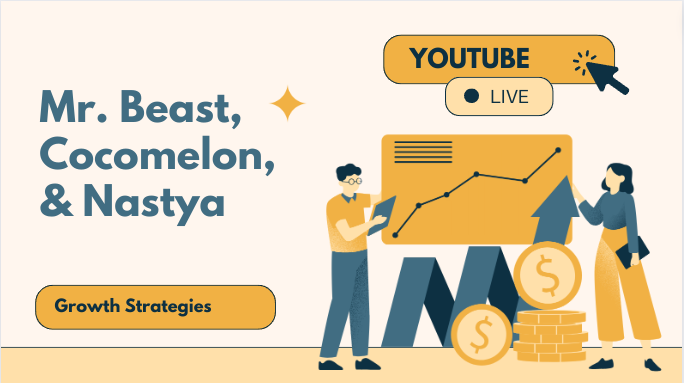
Ever scratched your head, wondering how some YouTube channels seem to skyrocket overnight, reaching folks in every corner of the globe? Well, you’re not alone. Channels like Mr. Beast, Cocomelon, and Like Nastya have cracked the code, and it’s not just about viral videos or luck. It’s about reaching out to a global audience in a way that feels personal to them. How, you ask? Through a nifty strategy known as localization.
Localization isn’t just about translating your content; it’s about adapting it culturally and linguistically, making it resonate with viewers worldwide. So, grab your notepad, and let’s unravel the secrets behind YouTube’s power players and how you can apply these strategies to your own channel.here the How to Use Youtube for Business: 10 Strategies for Beginners and 20 Key Strategies For Advance
The Magic of Language-Specific Channels
Imagine walking into a party where everyone speaks your language, even if they’re from different parts of the world. Feels welcoming, right? That’s exactly what Mr. Beast and Cocomelon do by creating language-specific channels. They craft content that speaks directly to viewers in their native tongues, making the connection feel more personal.
Real Talk: Mr. Beast didn’t just stop at English; he expanded his empire by creating channels in Spanish, Portuguese, and Russian, among others. Each channel tailors content to its audience, transcending language barriers and cultural differences. And Cocomelon? They create nursery rhymes that kids around the globe can enjoy, learning and singing in languages from English to Spanish.

Pro Tip: Starting a language-specific channel might seem like a Herculean task, but with the right team and a clear understanding of your target audience, it’s totally doable. Think about which languages your content will thrive in and start there.
One Channel, Multiple Languages: A Versatile Approach
Not keen on managing multiple channels? No worries. Like Nastya shows us another brilliant strategy: one channel, multiple languages. This little superstar shares her adventures in several languages on the same channel, using subtitles and dubbed content, making her relatable to kids and parents worldwide.
Behind the Scenes: This approach might seem less complicated, but it requires a keen eye on how to seamlessly integrate different languages without alienating segments of your audience. Like Nastya nails this by ensuring her content is universally appealing, making everyone feel included.
How to Get There: If you’re thinking of going down this route, focus on creating content that transcends cultural nuances. Subtitles are your best friend, and occasionally, dubbing can make a big difference.
Unlocking Global Reach with Localization
So, you’re pumped to reach a global audience. But where do you start? Localization is your golden ticket. It’s more than just translation; it’s about connecting on a deeper level.
- Human vs. AI-dubbed Content: While AI technology is booming, human-dubbed content has a warmth that AI just can’t replicate yet. However, AI can be a cost-effective and quick alternative, especially when you’re starting out.
- Multi-Language Subtitles: They are a game-changer. Not only do they make your content more accessible, but they also improve your SEO on YouTube. More languages mean more people can discover your content through search.
Inclusive Video Content: Beyond Language
Let’s not forget, localization is not just about language. It’s also about cultural nuances. When crafting content, think about universal themes that connect us all, regardless of where we come from. Humor, kindness, and storytelling are universal languages that can help your content resonate globally.
Real-Life Inspiration: Look at how Mr. Beast’s challenges and philanthropy cut across cultural boundaries. His message of giving and fun speaks to a global audience because kindness knows no language barrier.
Practical Tips for Implementing Your Localization Strategy
Ready to take the plunge? Here’s how to start:
- Identify Your Target Audience: Who are they? What languages do they speak? Dive into your analytics to understand your viewers better.
- Choose Your Approach: Whether it’s launching language-specific channels or incorporating multiple languages into one channel, select what best fits your content and resources.
- Start Small: Pick one additional language to start with, based on your audience insights. Test, learn, and then expand gradually.
- Use the Right Tools: From translation services to subtitle generators, there’s a plethora of tools out there to help you localize your content effectively.
Navigating the Challenges of a Global Strategy
Embarking on a global YouTube strategy is exciting, but it’s not without its challenges. Consistency across languages, maintaining content quality, and managing multiple channels or language versions can be daunting. Yet, with a solid plan and a focus on authentic engagement, the world really is your oyster.
So, What’s the Bottom Line?
Expanding your YouTube channel to a global audience through localization is like throwing a wider net; you’re bound to catch more fish. By understanding and implementing the strategies of YouTube’s titans like Mr. Beast, Cocomelon, and Like Nastya, you can pave your path to global success.
Remember, at the heart of successful localization is the desire to connect and engage with people, no matter where they are in the world. With a bit of strategy, creativity, and empathy, your channel can be the next big hit across continents.
Now, over to you: Are you ready to take your YouTube channel global? What strategies are you excited to try? Let’s chat in the comments below!

